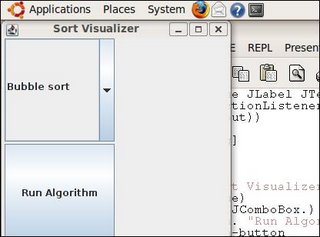There's some great
Clojure video online at
Blip.TV. I started watching
Clojure for Lisp Programmers. The following are brief notes on this.
Clojure was designed for concurrency and also targeted specifically at the
Java Virtual Machine. Apparently it's OK to hate Java, but like the virtual machine. Clojure is a "language as platform" implementation rather than language + platform. This gives the benefits that you get lots of stuff for free (e.g. the virtual machine, garbage collection, byte code generation, JIT compilation etc). Compare this to most Lisp implementations where you have to build this yourself and Clojure's off to a good start!
The focus is on concurrency because we're approaching the limit of single-core speed ups (whether that's actually true or not is debatable, but certainly
Intel and
AMD seem to be pushing us to a multi-core future). As has been said many times before functional programming is ideally suited for concurrency - no shared state hugely simplifies things. However, Clojure isn't a pure language like
Haskell; if you need to get "dirty" and modify state you can.
Clojure is not object-oriented because it encourages mutable state. "Mutable stateful objects are the new spaghetti code" was a great quote! Object-oriented polymorphism is very restrictive, CLOS has shown how useful basing it on multiple types can be, but can also base it on values, current state, relationships etc.
Clojure is a different kind of lisp for several reasons:
* First class support for sets, maps, lists and vectors (first class meaning Lisp reader support for example)
* Abstractions (all containers defined as
seq interface)
* Thread aware
* Host embracing (e.g. tightly tied to the JVM)
* Not constrained by backwards compatability.
In compared to other Lisp's:
* Clojure is a lexically scoped Lisp1
* Common Lisp style macros and dynamic vars
* Dynamically compiled to JVM byte code
* No tail call optimization
In the video, Rich Hickey discussed the recent
JVM summit and his (and most other attendees) hopes for getting support for TCO in the JVM. However according to a
recent article support it not coming in Java 7. Worst yet, if Java 7 is 2010 then we've a long wait till Java 8!
One of the fundamental differences between Lisp and Clojure is that Lisp doesn't have the
cons cell as the primary building block. Instead of a concrete implementation for lists, Clojure is based on the simple abstraction of first and rest. The
seq interface is common across all containers (list,map,set,vector,string,regex matches,files etc).
(seq x) will give you an available sequence interface from
x.
(conj x 6) will append a six on the end of any sequence.
Lazy seqs is also possible using the lazy-cons macro. As an example,
take (which returns the first n values of a potentially infinite collection), can be defined as:
(defn take [n coll]
(when (and (pos? n) (seq coll)) ;pos? positive number
(lazy-cons (first coll)
(take (dec n) (rest coll)))))
From the brief look of the video, the standard library has lots of neat little functions e.g.
(drop 2 [1 2 3 4]) ; (3 4)
(take 9 (cycle [1 2 3 4])) ; (1 2 3 4 1 2 3 4 1)
(interleave [:a :b :c :d :e] [1 2 3 4 5]) ;(:a 1 :b 2 :c 3 :d 4 :e 5)
(partition 3 [1 2 3 4 5 6]) ; ((1 2 3) (4 5 6))
(map vector [:a :b :c] [1 2 3]) ; ([:a 1] [:b 2] [:c 3])
(apply str (interpose \, "asdf")) ; "a,s,d,f"
(reduce + (range 100)) ; 4950
And I'm only an hour into the video before work has to kick in :(

